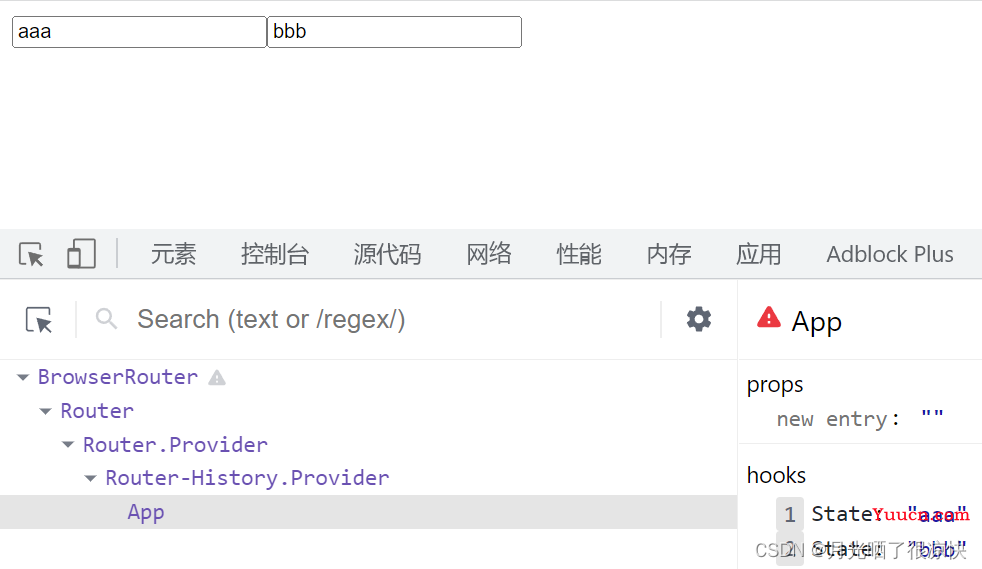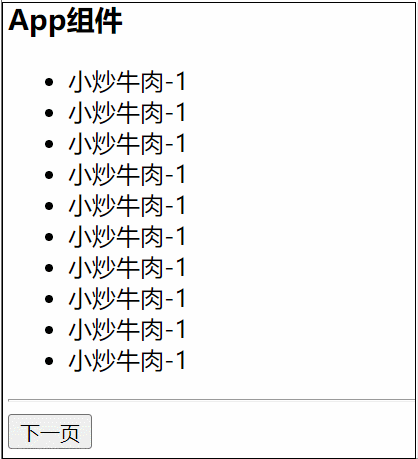1. 简介
在 React 的世界中,有容器组件和 UI 组件之分,在 React Hooks 出现之前,UI 组件我们可以使用函数组件,无状态组件来展示 UI,而对于容器组件,函数组件就显得无能为力,我们依赖于类组件来获取数据,处理数据,并向下传递参数给 UI 组件进行渲染。React在v16.8 的版本中推出了 React Hooks 新特性,Hook是一套工具函数的集合,它增强了函数组件的功能,hook不等于函数组件,所有的hook函数都是以use开头。
使用 React Hooks 相比于从前的类组件有以下几点好处:
- 代码可读性更强,原本同一块功能的代码逻辑被拆分在了不同的生命周期函数中,容易使开发者修改代码时不易去查找,通过 React Hooks 可以将功能代码聚合,方便维护
- 组件树层级变浅,在原本的代码中,我们经常使用 HOC/render/Props 等方式来复用组件的状态,增强功能等,无疑增加了组件树层数及渲染,而在 React Hooks 中,这些功能都可以通过强大的自定义的 Hooks 来实现
使用hook限制:
- hook 只能用在函数组件中,class 组件不行
- 普通函数不能使用 hook,默认只能是函数组件才能用
例外:普通函数名称以 use 开头也可以,(自定义的函数以 use 开头,称为自定义 hook)
- 函数组件内部的函数也不能使用 hook
- hook 函数一定要放在函数组件的第一层,别放在 if/for 中(块级作用域)
- 要求函数组件名称必须首字母大写
2. useState使用
概述:
类组件中有一个状态属性,可以通过此特殊属性完成私有数据的操作。操作此 state 数据可以触发视图更新(this.setState())。
函数组件中,从 react16.8 之后,提供一个 hook 函数 useState 方法,它可以模拟出类组件中的状态。
语法:
let [变量,函数] = useState(值|()=>值)
变量就可以得到useState中的值,函数就可以修改值。值的存储使用了闭包。
使用:
import React, { useState } from 'react';
const App = () => {
// 相当于在App函数组件是定义一个state数据,变量名为 count,修改此count的值的方法为setCount
// 写法1:值
// let [count, setCount] = useState(100)
// 有的时候,在项目中的初始数据,要经过一系列的运算才能出来的初始值,这时候就可以使用函数的写法
// 写法2:函数
let [count, setCount] = useState(() => 100)
const addCount = () => {
setCount(count + 1)
}
return (
<div>
<h1>{count}</h1>
<button onClick={addCount}>++++</button>
</div>
);
}
export default App;

处理并发操作:
import React, { useState } from 'react';
const App = () => {
let [count, setCount] = useState(() => 100)
const addCount = () => {
// 并发处理数据的完整性得不到保证
// setCount(count + 1) // 100+1
// setCount(count + 1) // 100+1
// setCount(count + 1) // 100+1
// 并发处理 -- 推荐写法,这样写数据的完整性可靠的
setCount(v => v + 1)
setCount(v => v + 1)
setCount(v => v + 1)
}
return (
<div>
<h1>{count}</h1>
<button onClick={addCount}>++++</button>
</div>
);
}
export default App;

使用useState完成表单项自定义hook函数:
如果我们有两个 input 框需要变为受控组件,我们可以这样写:
import React, { useState } from 'react';
const App = () => {
let [username, setUsername] = useState('')
let [password, setPassword] = useState('')
return (
<div>
{/* 受控组件 */}
<input type="text" value={username} onChange={e => setUsername(e.target.value)} />
<input type="text" value={password} onChange={e => setPassword(e.target.value)} />
</div>
);
}
export default App;

上面的做法让 return 部分的代码太过复杂,我们可以使用自定义 hook 函数来简化这部分的代码:
import React, { useState } from 'react';
// 在react中,定义的函数是以use开头,则认为它就是一个自定义hook函数
// 在自定义hook函数中,可以调用内置hook
function useInput(initialValue = '') {
let [value, setValue] = useState(initialValue)
return { value, onChange: e => setValue(e.target.value.trim()) }
}
const App = () => {
let usernameInput = useInput('')
let passwordInput = useInput('')
return (
<div>
{/* 受控组件 */}
<input type="text" {...usernameInput} />
<input type="text" {...passwordInput} />
</div>
);
}
export default App;

我们还可以使用模块化的思想,将自定义 hook 函数拆分到另一个文件中:
useInput.js:
import { useState } from 'react';
// 在react中,定义的函数是以use开头,则认为它就是一个自定义hook函数
// 在自定义hook函数中,可以调用内置hook
const useInput = (initialValue = '') => {
let [value, setValue] = useState(initialValue)
return { value, onChange: e => setValue(e.target.value.trim()) }
}
export default useInput
App.jsx:
import React from 'react';
import useInput from './hook/useInput';
const App = () => {
let usernameInput = useInput('')
let passwordInput = useInput('')
return (
<div>
<input type="text" {...usernameInput} />
<input type="text" {...passwordInput} />
</div>
);
}
export default App;

3. useEffect使用
概述:
此 hook 可以模拟函数组件的生命周期,函数组件对于在一些生命周期中操作还是无能为力,所以 React 提供了 useEffect 来帮助开发者处理函数组件,来帮助模拟完成一部份的开发中非常常用的生命周期方法。常被别的称为:副作用处理函数。此函数的操作是异步的。
它并不能模拟全部的钩子函数,它只能模拟下面这几个:componentDidMount、componentDidUpdate、componentWillUnmout。
注意:useEffect中不能有返回值,React它要自动回收
比如说下面这种场景,我们希望 console.log 函数中的内容只打印一次,但是每当试图更新的时候,console.log 都会重新执行:
import React, { useState } from 'react';
const App = () => {
let [count, setCount] = useState(100)
const addCount = () => setCount(count + 1)
console.log('App -- 要求此处只打印一次');
return (
<div>
<h3>App组件 --- {count}</h3>
<button onClick={addCount}>++++</button>
</div>
);
}
export default App;

这时候我们就可以使用 useEffect 函数来实现上述需求。
使用:
模拟:componentDidMount componentDidUpdate
import React, { useState, useEffect } from 'react';
const App = () => {
let [count, setCount] = useState(100)
const addCount = () => setCount(count + 1)
// 模拟:componentDidMount componentDidUpdate(可以调用多次)
useEffect(() => {
console.log('App -- useEffect');
})
return (
<div>
<h3>App组件 --- {count}</h3>
<button onClick={addCount}>++++</button>
</div>
);
}
export default App;

模拟:componentDidMount(这种写法可以模拟网络请求)
import React, { useState, useEffect } from 'react';
const App = () => {
let [count, setCount] = useState(100)
const addCount = () => setCount(count + 1)
// 模拟:componentDidMount(可以调用多次)
// 参数2:依赖项,如果为空数据,则只执行1次
// 一般在这样的写法中,完成网络请求
useEffect(() => {
console.log('App -- useEffect');
}, [])
return (
<div>
<h3>App组件 --- {count}</h3>
<button onClick={addCount}>++++</button>
</div>
);
}
export default App;

利用依赖项,模拟componentDidMount、componentDidUpdate
import React, { useState, useEffect } from 'react';
const App = () => {
let [count, setCount] = useState(100)
let [name, setName] = useState('')
const addCount = () => setCount(count + 1)
// 下面这种写法,也可以实现相同的功能
// let [count, setCount] = useState({ num: 100 })
// const addCount = () => setCount({ num: count.num + 1 })
// const addCount = () => setCount(v => ({ num: v.num + 1 }))
// 参数2中依赖项,进行填值,只要依赖项中的值,发生改变,则进行触发
// componentDidMount componentDidUpdate
useEffect(() => {
console.log('App -- useEffect');
// 这里的依赖项中只填了count,所以只有count发生改变,才会触发当前函数
}, [count])
// 对依赖项的使用,可以像下面这样分开写,也可以写在同一个数组中
// useEffect(() => {
// console.log('App -- useEffect');
// }, [name])
return (
<div>
<input value={name} onChange={e => setName(e.target.value)} />
<h3>App组件 --- {count}</h3>
<button onClick={addCount}>++++</button>
</div>
);
}
export default App;

有依赖项,模拟:componentDidMount、componentDidUpdate、componentWillUnmout
import React, { useState, useEffect } from 'react';
const App = () => {
let [count, setCount] = useState(100)
let [name, setName] = useState('')
const addCount = () => setCount(count + 1)
// 有依赖项,只要count改变,则触发
// componentDidMount componentDidUpdate componentWillUnmout
useEffect(() => {
console.log('App -- useEffect');
// 返回回调函数中就是 componetWillUnMount
// 在执行下一个 effect 之前,上一个 effect 就已被清除
return () => {
console.log('componentWillUnmout');
}
}, [count])
return (
<div>
<input value={name} onChange={e => setName(e.target.value)} />
<h3>App组件 --- {count}</h3>
<button onClick={addCount}>++++</button>
</div>
);
}
export default App;

模拟组件销毁
import React, { useState, useEffect } from 'react';
const App = () => {
let [count, setCount] = useState(100)
let [name, setName] = useState('')
const addCount = () => setCount(count + 1)
return (
<div>
<input value={name} onChange={e => setName(e.target.value)} />
<h3>App组件 --- {count}</h3>
{
count > 103 ? null : <Child />
}
<button onClick={addCount}>++++</button>
</div>
);
}
function Child() {
// componentDidMount componentWillUnmout -- 一般模拟组件的销毁
useEffect(() => {
console.log('child -- componentDidMount');
return () => {
console.log('child -- componentWillUnmout');
}
}, [])
return (
<div>
<h3>Child</h3>
</div>
)
}
export default App;

useEffect发起网络请求
import React, { useState, useEffect } from 'react';
import { get } from '@/utils/http'
const App = () => {
let [films, setFilms] = useState([])
// useEffect
// 在之前的版本:第1个参数要求只能是一个普通的函数,没有返回对象,可以返回回调函数,回调函数它模拟生命周期componentWillUnmout
// 还有最后一个问题。在代码中,我们使用async / await从第三方API获取数据。如果你对async/await熟悉的话,你会知道,每个async函数都会默认返回一个隐式的promise。但是,useEffect不应该返回任何内容。这就是为什么会在控制台日志中看到以下警告:
// Warning: useEffect function must return a cleanup function or nothing. Promises and useEffect(async () => …) are not supported, but you can call an async function inside an effect
useEffect(async () => {
let ret = await get('/api/swiper')
setFilms(ret.data)
}, [])
// 如果useEffect顶层不支持 async/await可以使用如下的解决方案
/* useEffect(() => {
; (async function () {
let ret = await get('/api/swiper')
setFilms(ret.data)
})()
}, []) */
return (
<div>
<h3>App组件</h3>
<ul>
{
films.map(item => (
<li key={item.id} > {item.title}</li>
))
}
</ul>
</div >
);
}
export default App;

useEffect 封装网络请求:
useSwiper.js:
import { useEffect, useState } from 'react';
import { get } from '@/utils/http'
const useSwiper = (initialValue = []) => {
let [data, setData] = useState(initialValue)
useEffect(async () => {
let ret = await get('/api/swiper')
setData(ret.data)
}, [])
return data
}
export default useSwiper
App.jsx:
import useSwiper from "./hook/useSwiper";
const App = () => {
let data = useSwiper()
return (
<div>
<h3>App组件</h3>
<ul>
{
data.map(item => (
<li key={item.id} > {item.title}</li>
))
}
</ul>
</div >
);
}
export default App;

封装网络请求时,实现分页:
useGoodFood.js:
import { useEffect, useState } from 'react';
import { get } from '@/utils/http'
const useGoodFood = (initialValue = []) => {
let [data, setData] = useState(initialValue)
let [page, setPage] = useState(1)
const loadData = async () => {
let ret = await get('/api/goodfood?page=' + page)
if (ret.data.length > 0) {
// setData(v => [...v, ...ret.data])
setData(ret.data)
setPage(v => v + 1)
}
}
useEffect(() => {
loadData()
}, [])
return [data, loadData]
}
export default useGoodFood
App.jsx:
import useGoodFood from "./hook/useGoodFood";
const App = () => {
let [data, loadData] = useGoodFood()
return (
<div>
<h3>App组件</h3>
<ul>
{
data.map(item => (
<li key={item.id} > {item.name}</li>
))
}
</ul>
<hr />
<button onClick={() => {
loadData()
}}>下一页</button>
</div >
);
}
export default App;

到此这篇关于React中hook函数与useState及useEffect的使用的文章就介绍到这了,更多相关React中hook函数内容请搜索本站以前的文章或继续浏览下面的相关文章希望大家以后多多支持本站!